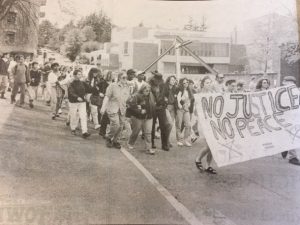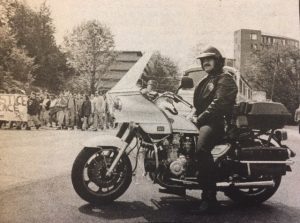Analysis
After placing our research on a timeline, we were left with a few questions. Below, we attempt to answer those questions by extrapolating meaning from the data we discovered.
How are protests against police brutality conducted at Western?
WWU’s student newspaper, The Western Front, served as an invaluable tool in finding examples and information on student activism. In the years before 1970, student activism during moments of police brutality were primarily small, often only side mentions in Front editorials or details in larger stories about racial inequality and injustice. We discovered in countless editorials throughout issues of the Front in the 1960’s, for example, mentioning of police brutality as an issue of concern to students. In an interview with a member of the Seattle branch of the Black Panther Party, the Front published a list of ten demands made by the party to the United States government, including stopping the strong tides of police violence being enacted across the country. During the Vietnam War, police brutality began garnering individual attention and prompting outcries on campus.
After the Kent State massacre in May of 1970, nearly 2000 Western students joined together to boycott classes, hold rallies and teach-ins, and ultimately force college president Charles Flora to write a letter in response to the protests calling for peace. From there, examples of mobilization and activism become far less rare.
Only days later, Western’s Black Student Union requested that classes be cancelled following the Jackson State police murder of two black students. President Flora denied the request, and instead flags were flown at half mast for a day while classes continued as usual.
In 1992, another huge uproar swept WWU after the Rodney King verdict. In this instance, on top of requests for class cancellations, marches, and protests, students also mobilized against local police, calling for greater community between county police and residents as well as more sensitivity training and hard looks at the racism within our own community.
In more recent years, protests were held following the Michael Brown shooting. In 2016, a march and community building event was held for local women of color to protest police violence against women and to create a safe space for WOC in Bellingham to make their voices heard/
Rallies and teach-ins prove to be the most common forms of protest throughout Western’s history. While student’s have attempted to shut down the college multiple times to protest police brutality, they have had far greater success drawing attention to their cause by holding large rallies in Red Square. As time moves forward, we see that Western students are separating themselves from national news far less and instead are responding to mass cases of police brutality by looking inward, protecting communities at home and creating local change.
Why are protests conducted?
Perhaps the biggest surprise while conducting this research is how little of it there truly is. Again, The Western Front primarily discussed police brutality in small mentions while discussing larger stories, like immigration or the Black Panther Party’s goals as opposed to stories highlighting specific protests, which is what we were after. The archives had little original material at all. However, at the start of the 1970’s we see an uptick in police protests and more research material at hand. There are a few interpretations of why that might be. In 1965, Dr. Harvey C. Bunke was elected President of the college and held that title until 1967. Notably, he was a leading proponent of freedom of the press for students, and promoted students’ expressions of controversial viewpoints and interests. That encouragement could have (and probably did) allow for a more expressive environment for students. At the same time, the U.S. was experiencing a cultural shift, especially among college aged people, where challenging authority and expressing political viewpoints was becoming far more common. Those two factors surely played a role in student activism flourishing beginning in 1970. Another reason why student activism may have flourished at the start of the 70’s is because of the massive anti war efforts happening on other college campuses around the country. The Kent State massacre in May of 1970, wherein 4 college students protesting the war were killed by police reverberated around the country and resonated with anti-war protesters at Western, who now began to direct considerable energy into protesting violent policing.
The media frenzy surrounding modern cases of racism and brutality in the country’s police forces saw a resurgence of activism against police brutality. The Rodney King case of the early 90’s brought hundreds of students out to protest, as well as the murder of Michael Brown in more recent history. According to killedbypolice.net, 1156 people were killed by police in the year 2016 alone, compared to around 2,500 victims in the 10 years of the 1990’s, a staggering statistic that has drawn outrage from activists all across the country and here at WWU, resulting in more marches, more rallies, and more cries for change in our criminal justice system.


